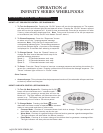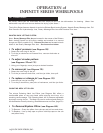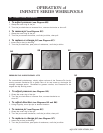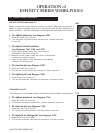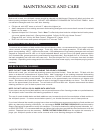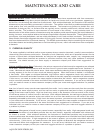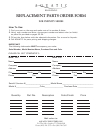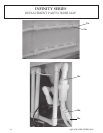
AQUATIC INDUSTRIES, INC. 25
MAINTENANCE AND CARE
WATER QUALITY ISSUES (continued):
2. CHEMICAL QUALITY
The water supplied by individual wells or water systems always contains chemicals, usually in amounts below
those which the consumer would notice. Examples of such chemicals, which are of potential concern for the
owners of fill and drain whirlpool bathtubs, are calcium and magnesium salts, copper, iron, manganese and
sulfates. When these chemicals are present in sufficient amounts, they may cause problems in whirlpool
bathtubs. You should contact your water supply or treatment company and follow their suggestions for
treatment.
Calcium and Magnesium Salts- Collectively, the various compounds of calcium and/or magnesium are referred
to as salts. Calcium and magnesium salts are often found in ground water supplies and cause “hardness” in
water. Hard and soft water are relative terms. Hard water retards the cleaning action of soaps and detergents,
causing expense in the form of extra work and cleaning agents. When hard water is heated, it will deposit
a hard scale. With regard to whirlpool bathtubs, high calcium and/or magnesium levels may result in the
formation of white stains and scale formation on the inside of the tubs, especially noticeable with colored tubs.
If this occurs, you need to contact the water supplier to determine the calcium and/or magnesium content
and/or corrosion potential of the water and follow their suggestions for treatment. If you are on an individual
well, you need to contact a water treatment company to test your water and suggest solutions if a problem
is present.
Iron- Iron is found in many natural waters especially from wells. Iron in water can also result from the corrosion
of piping in the water supply system, such as cast iron mains or galvanized steel service lines, or galvanized
piping in the home water system. High iron levels may result in the formation of brown stains in the vicinity
of the faucet outlets of various fixtures in the home. With whirlpool bathtubs, the staining may be particularly
pronounced because the aeration action can oxidize iron to a form that settles out on the inside of the tubs,
especially noticeable in white tubs. If high iron in the water is present, you can also notice rust colored deposits
in your toilet tank or dishwasher. If this occurs, you need to contact the water supplier to determine the iron
content and/or corrosion potential of the water and follow their suggestions for treatment. If you are on an
individual well, you need to contact a water treatment company to test your water and suggest solutions if
a problem is present.
Manganese- Manganese is found in many natural waters, especially from wells. High manganese levels may
result in the formation of small black particles that can stain laundry, especially noticeable with whites such
as sheets or towels. With whirlpool bathtubs, the formation of small black particles may be particularly
pronounced because the aeration action in the tub can oxidize manganese to an insoluble form that is especially
noticeable with white tubs. If high manganese in the water is present, you may also notice black stains on
white laundry. If this occurs, you need to contact the water supplier to determine the manganese content of
the water and follow their suggestions for treatment. If you are on an individual well, you need to contact a
water treatment company to test your water and suggest solutions if a problem is present.
Pigmented Bacteria- Water utilities from all over the United States have experienced calls from consumers
inquiring and complaining about pinkish substance on bathroom fixtures that is very persistent, appearing in
the shower, sink and along the water line of toilet bowls. With whirlpool bathtubs, the formation of this colored
substance may be particularly pronounced in white tubs. The residue is less likely a problem associated with
water quality than with naturally occurring airborne bacteria. The bacteria may produce a pinkish film, and
sometimes a dark gray film, on surfaces that are regularly moist, including toilet bowls, shower heads, sink
drains, and tiles. The problem is more common in humid areas of the country. In any particular case, the
determination of the exact species of bacteria causing the problem would require lengthy and costly laboratory
testing; however, most experts believe the bacteria responsible is Serratia marcescens. These bacteria thrive
on moisture, dust and phosphates, and are widely distributed in soil, food and also in animals. The American
Water Works Association suggests that short of buying pink fixtures, the best solution to keep these surfaces
free from the bacterial film is continual cleaning. The AWWA recommends a chlorine containing the compound
as the best cleaner and avoiding abrasives to avoid scratching fixtures, which will make them more susceptible
to bacteria.



